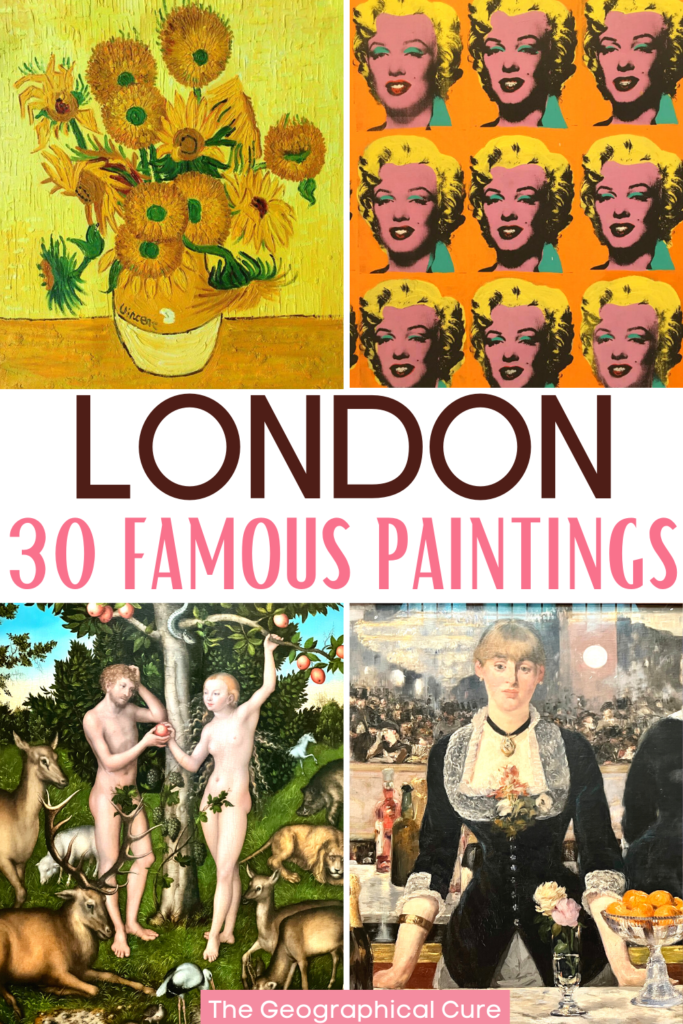Wondering what art you need to see in London? You’ve come to the right place. Here’s my guide to 30+ must see famous paintings in London.
When it comes to art, London is frankly mind boggling. The city is an art lover’s paradise, literally overflowing with fantastic museums displaying world class works of art.
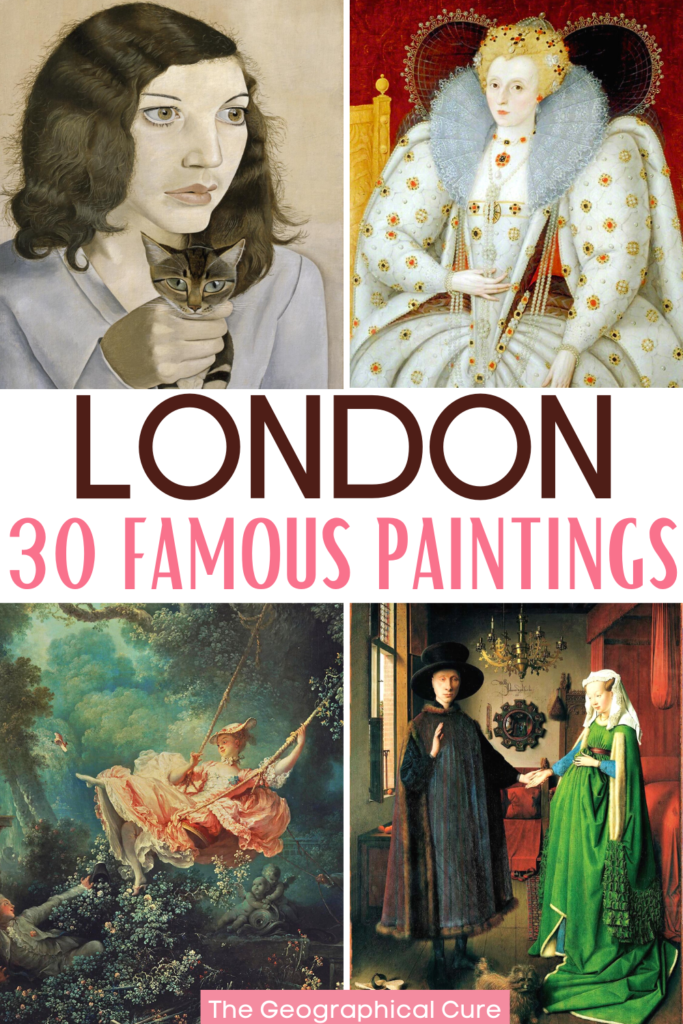
You can find these famous London paintings at world renowned museums like the National Gallery of Art and the Tate Modern.
But some of these famous paintings in London are also tucked away in small hidden gem museums and house museums.
In this guide, I give you an overview of 30+ paintings and art works in London and tell you where to find them.
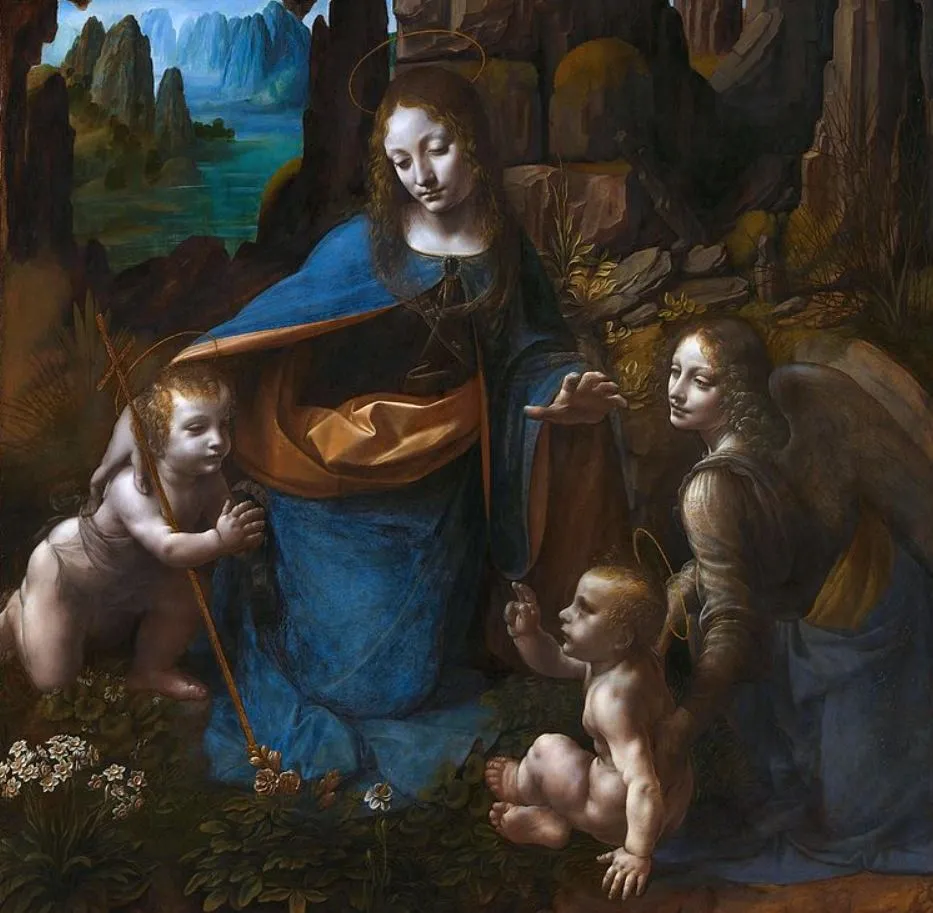
Famous Paintings In London
Here are my picks for 30+ must see paintings in London, for your London art bucket list. I’ve grouped the paintings by which museum you’ll find them in.
National Gallery of Art
1. Leonardo da Vinci, The Virgin of the Rocks
Virgin of the Rocks is the most famous painting in the National Gallery of Art and perhaps all of London. It’s one of only 16 authenticated Leonardo da Vinci paintings in the world.
Leonardo’s painting shows the infant St. John the Baptist meeting the holy family as they flee to Egypt to escape Herod’s Massacre of the Innocents. The painting has Leonardo’s trademark mystical landscape, complete with grotto-like rock formations in the background.
The figures are grouped in a pyramid to give the illusion of space. Mary’s face has a supernatural glow. She looks natural and is kneeling rather than being formally enthroned as the queen of heaven.
There is no indicia of the divine in the painting. In fact, Leonardo was the first Italian artist to do away with halos. This artistic departure made his painting more human and relatable to viewers.
>>> Click here to book a highlights tour of the National Gallery of Art
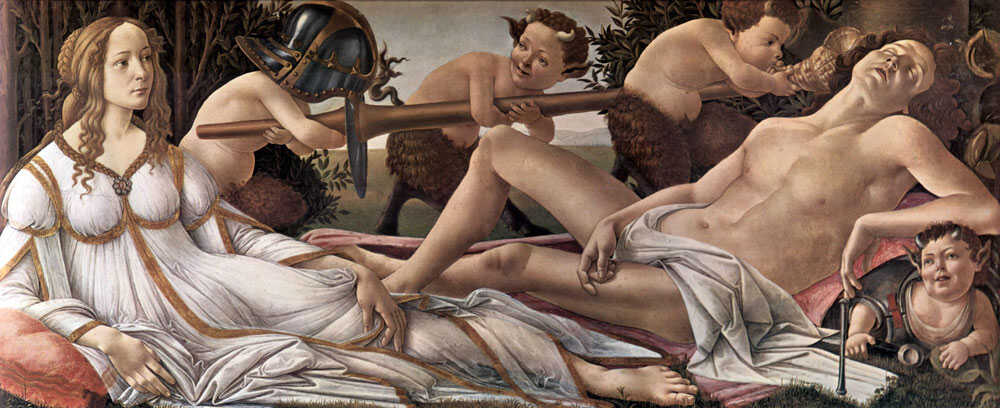
2. Sandro Botticelli, Venus and Mars
Florentine painter Sandro Botticelli was the greatest painter of the early Renaissance period. He was the first artist to paint large scale, non-religious mythological themes.
Venus and Mars is one of his most famous paintings. It’s pure visual poetry and elegance. The painting depicts the two deities lounging in a meadow.
Venus looks forward while Mars sleeps, appearing almost drugged. He’s oblivious to the buzzing wasps and devilish satyrs around him.
Some historians believe that the figures representing Mars and Venus are portraits of real life lovers Simonetta Vespucci and Giuliano de Medici (the brother of Lorenzo the Magnificent).
Other art historians believe they represent Adam and Eve or Mary Magdalene and Christ.
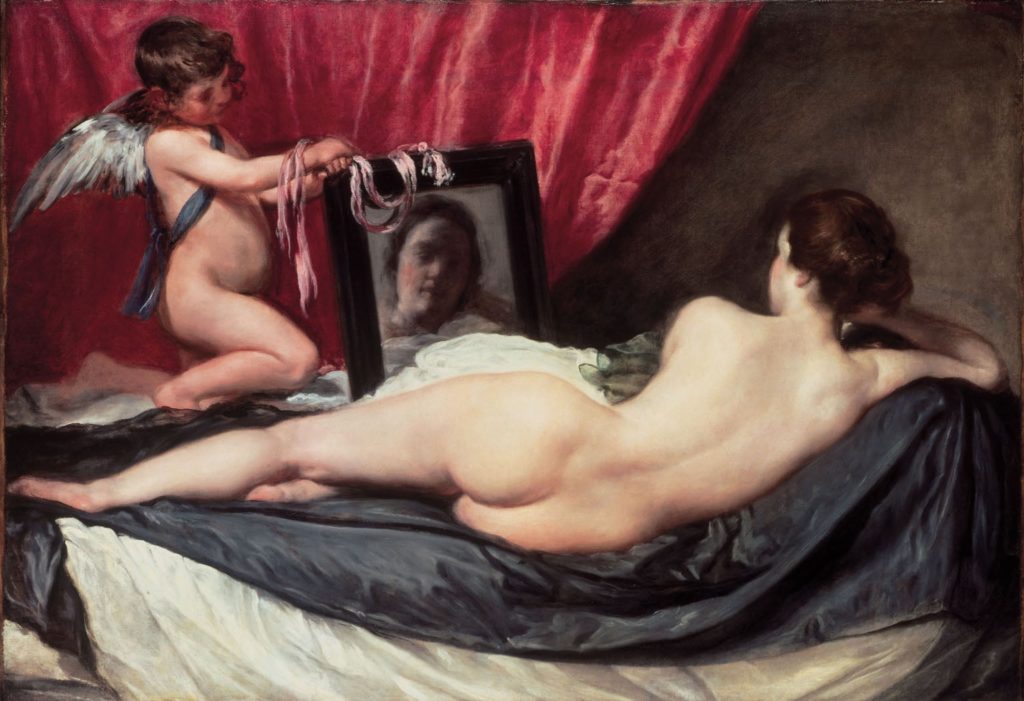
3. Diego Velazquez, The Rokeby Venus
The Spanish painter Velazquez was one of the greatest painters of 17th century Spain. His Toilet of Venus is also known as the Rokeby Venus because of the hall it hung in.
It’s an enigmatic painting. No one knows who commissioned it. It’s also Velazquez’s only surviving nude.
During the Spanish Inquisition, it was considered bold to paint nudes. Velazquez only got away with it because he was Philip IV’s court painter.
In the painting, the goddess of love lies languidly on a bed caught in mid primp. She’s identified as Venus because of a winged Cupid’s presence.
She’s nude and her back is to the viewer. Her unusual pose may be inspired by the ancient sculpture of the Sleeping Hermaphrodite in the Louvre.
Her curvy hip is highlighted by the white fabric in the center. It almost looks like she’s blushing.
Venus’ face is reflected in Cupid’s mirror. It makes the viewers think she’s looking back at them as they look at her, a trick known as the “Venus effect.” The painting is, in effect, about the act of looking.
As if to counter Venus’ vanity, her blurry face in the mirror seems older than her body, a reference to the inevitable passage of time.
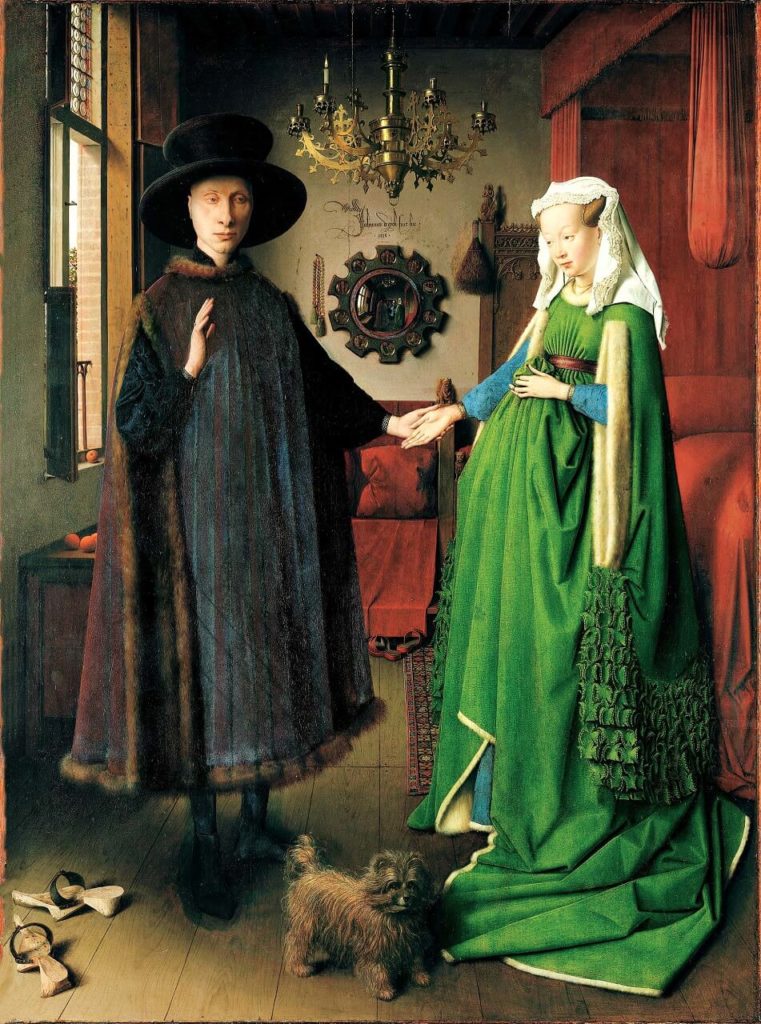
4. Jan van Eyck, The Arnolfini Wedding
The Arnolfini Portrait is considered the world’s first oil, rather than tempera, painting. It’s one of the most famous paintings in London.
It’s a stunning full length double portrait with astonishing realism and a rich color palette. Art historians don’t know who the sitters were, though there are multiple theories.
Some think the elegant composition depicts a wedding scene. Others think it’s a portrait of a wealthy merchant and his well dressed wife. Still others think it’s a memorial portrait, with the dog representing the woman’s death.
In any event, The Arnolfini Portrait is significant because it’s the the first entry in the genre of interior paintings of everyday life.
In the center back, a convex mirror glistens, providing an interesting perspective. Reflected in the glass are miniaturized versions of the couple.
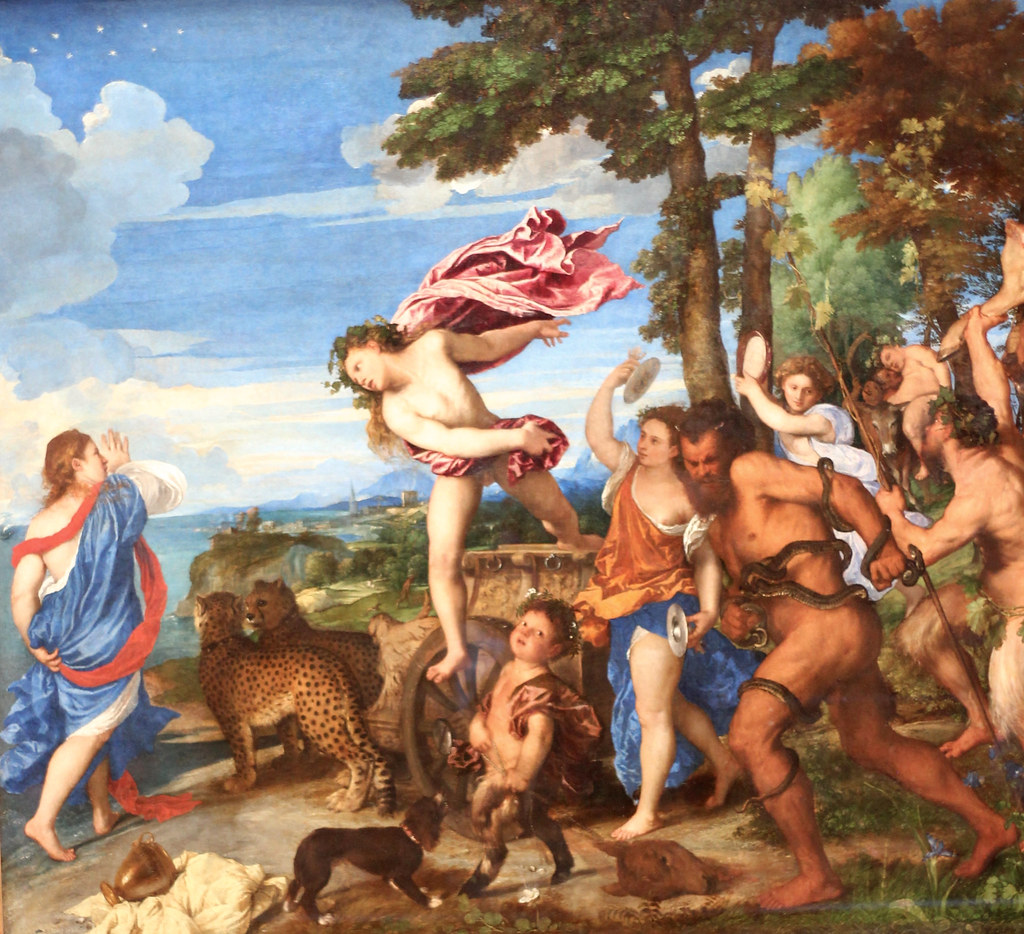
5. Titian, Bacchus and Ariadne
Titian is widely considered the most important and successful painter of the 16th century Venetian Renaissance school. He was the master of oil and a prolific producer of colorful paintings.
Bacchus and Ariadne was commissioned by Alfonso d’Este. The story of Bacchus and Ariadne hadn’t been portrayed by any artist before Titian.
In the Greek legend on which the painting is based, Ariadne helped Theseus vanquish the Minotaur and extract himself from the labyrinth. Theseus thanks her by abandoning her on the island of Naxos.
Ariadne is furious. But, in her moment of distress, she meets Bacchus, whose chariot is pulled by cheetahs.
Bacchus is so taken with her that he jumps from the chariot to meet her. Their eyes meet. It’s a beautiful depiction of love at first sight.
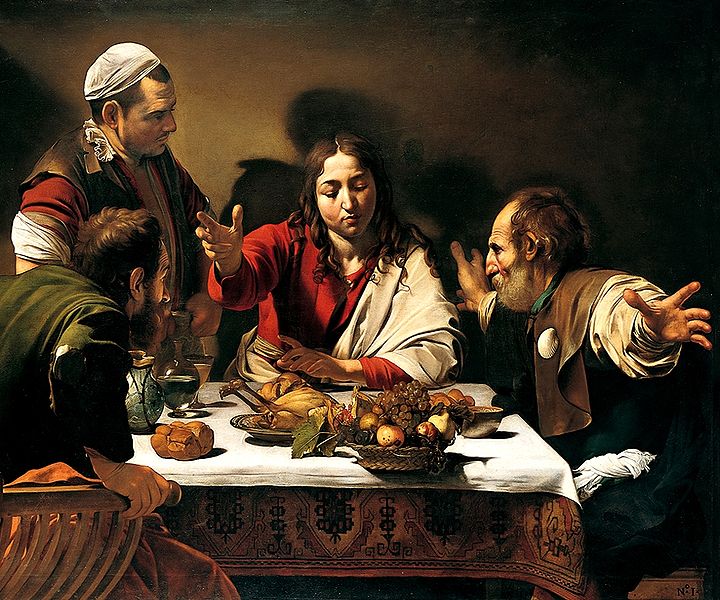
6. Caravaggio, The Supper at Emmaus
Caravaggio was the greatest painter of the Baroque era. He was a fiercely original artist who rendered his subjects in a photo-realistic way.
Caravaggio took the dramatic light-dark contrast called tenebrism to a harsh extreme. He also delighted in exalting the mundane and vulgar aspects of everyday life.
In this dynamic painting, Caravaggio depicts a common theme — Jesus’ first supper after his resurrection. Two disciples recognize him and are shocked. One flings his arms out mirroring a cross.
It’s a simple painting, though the gestures are theatrical. The light and dark tones create a tense atmosphere full of turmoil. Reinforcing this tone is the still life, which sits precariously on the edge of the table.
7. Vincent Van Gogh, Sunflowers
Van Gogh was a Dutch Post-Impressionist artist who spent most of his life in France. He only sold a few paintings in his lifetime. Van Gogh fit the stereotype of tortured artist.
Van Gogh wanted to be known as the painter of sunflowers. He started painting the thick stemmed blooms to experiment with color. Van Gogh painted 11 versions.
The Sunflowers in the National Gallery is one of his most famous paintings. It’s the most important of the artist’s series of sunflowers.
A young curator bought the painting from Van Gogh’s sister in law, Jo Bonger. Sunflowers is now the National Gallery’s most beloved painting.
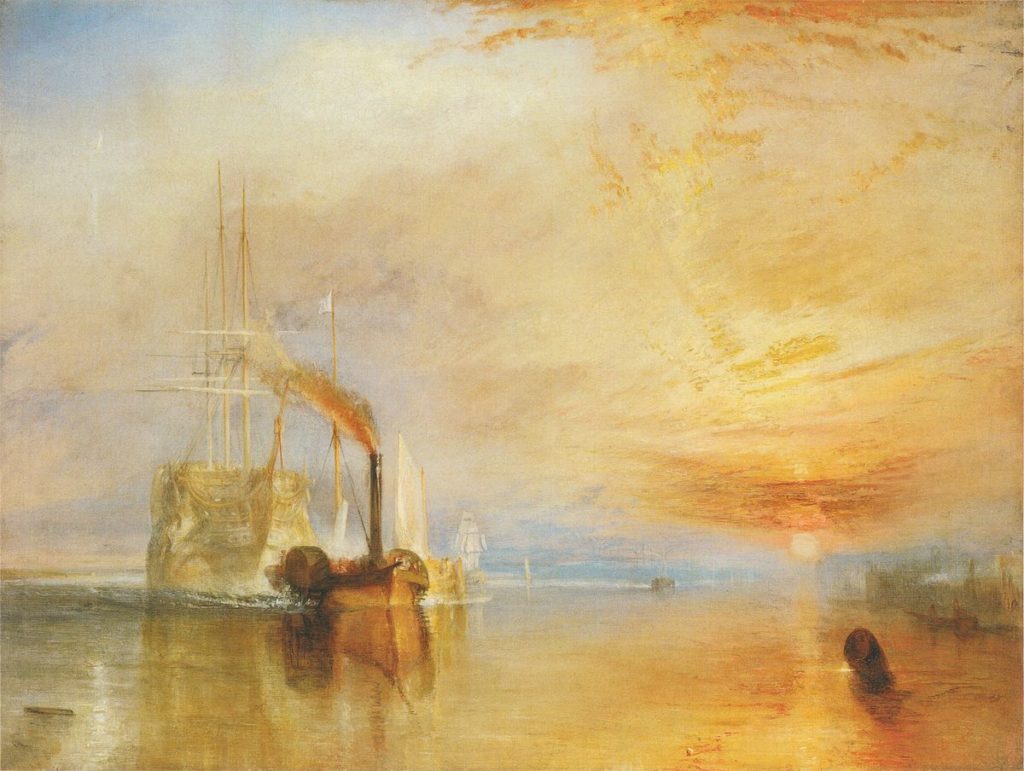
8. J.M.W. Turner, The Fighting Temararie
Turner helped found Romanticism, a movement that anticipated Impressionism decades later. He used painterly effects to create light saturated scenes.
The Fighting Temeraire is Turner is his prime. It’s one of the National Gallery’s most famous masterpieces.
Turner was a social chronicler. In this painting, he depicts the famous battleship Temeraire, from the Battle of Trafalgar, being towed away for scrap material. It’s thought to symbolize the decline of Britain as a seafaring power.
The artist’s skill is evident in the expert way he layers and shades the tones of the sea and sky. The dying light behind the bulk of the ship makes the scene appear more poignant.
Turner never sold the painting. When he died, he bequeathed it to the nation.
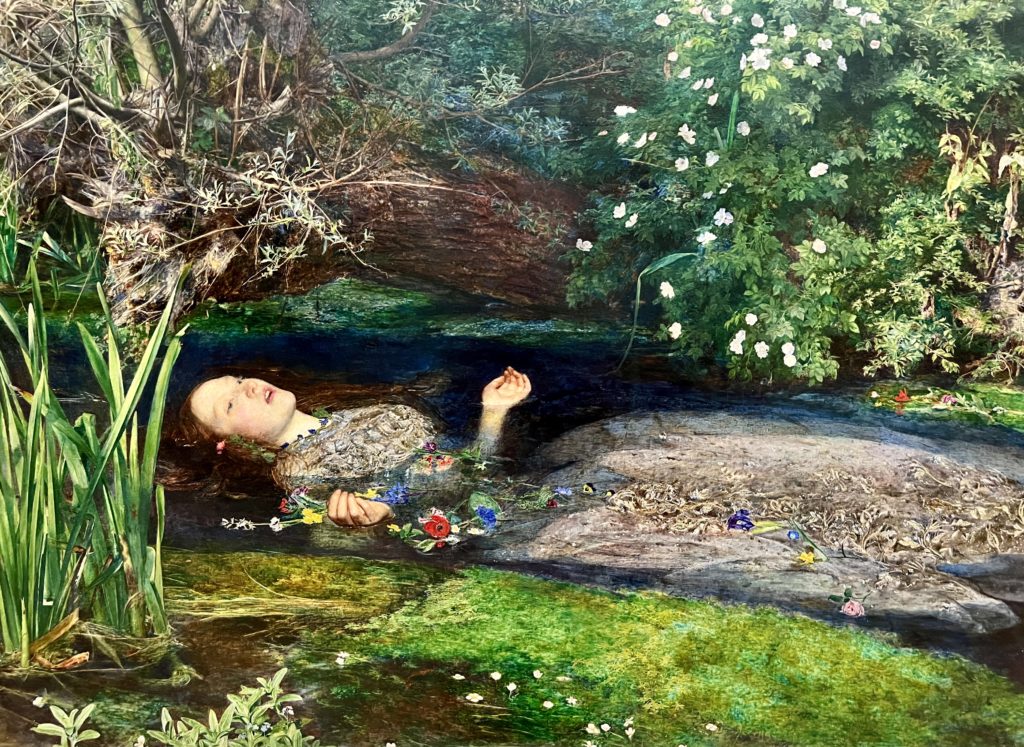
Tate Britain
9. John Everett Millais, Ophelia
Ophelia is a classic Pre-Raphaelite work. It has bright colors, a dreamy quality, and a poetic theme of wasted youth.
The unabashedly romantic painting is one of the most famous Shakespearean images in art. It depicts a drowned Ophelia, a character in Shakespeare’s Hamlet.
Ophelia is driven mad with grief when Hamlet murders her father. She falls into a stream and drowns.
In the painting, a pale and dark haired Ophelia is seemingly at peace with nature. She holds a variety of flowers. The poppies symbolize death, the daisies represent innocence, and the pansies reflect blighted love.
In its day, Ophelia was regarded as at the most accurate and elaborate study of nature ever made.
Millais’ model was Lizzie Siddal, a popular Pre-Raphaelite muse. Millais painted her lying in a bathtub, fully dressed. Lizzie contracted a severe cold, nearly died, and her father chased Millais to cover her doctor’s bill.
READ: Guide To The Tate Britain
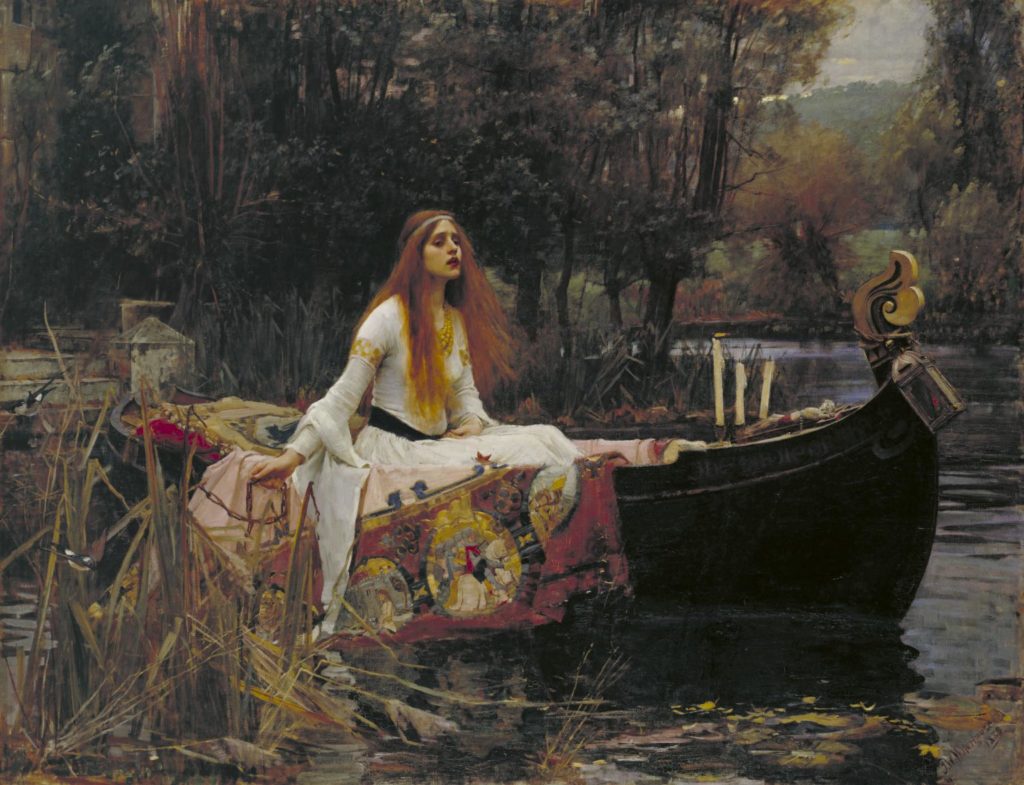
10. John William Waterhouse, The Lady of Shalott
Waterhouse’s The Lady of Shalott is an incredible masterpiece in the Tate Britain.
It transports viewers back forty years earlier when the Pre-Raphaelite Brotherhood dominated the middle of the century.
The subject is a vulnerable young red haired woman in a white gown. She’s set adrift in a boat in a river setting reminiscent of Ophelia.
The painting has the same mythical beauty as Ophelia. But Waterhouse’s painting has a more impressionistic delicacy.
The subject of the painting comes from Lord Alfred Tennyson’s Arthurian poem of the same name. In the poems, she lives isolated in a castle under a curse that only allows her to look at the outside world with a mirror.
But one day she spies Lancelot and can’t help but look at the handsome knight directly. The curse comes upon her as she drifts to Camelot on a boat.
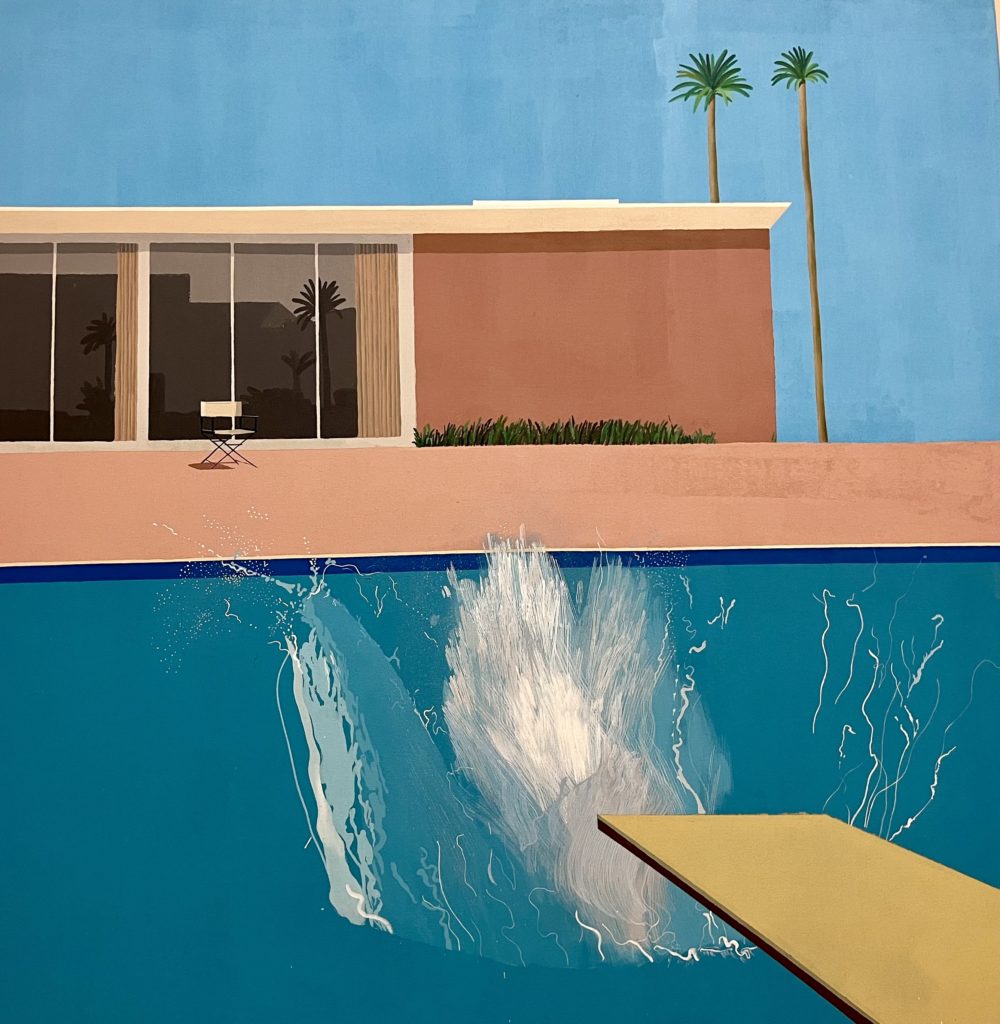
11. David Hockney, A Bigger Splash
Hockney is one of the most recognizable and popular British artists of our time. His main interest is the challenge of representation, trying to capture an object in two dimensions.
A Bigger Splash is an iconic work of Pop Art. Hockney painted it in the late 1960s when he moved to California. There are three versions of the painting.
It was a post-war period of optimism and Hockney’s depiction of a California swimming pool reflects this.
The spare but exuberant painting evokes a glamorous life of sun and leisure. The colorful painting verges on abstraction.
In many of his paintings, Hockney added male figures. But, in this one, the splash is all that suggests a human presence.
12. Francis Bacon, Three Studies For Figures at the Base of a Crucifixion
Francis Bacon is know for his emotionally charged raw imagery of traumatized humanity. Drifting inbetween figuration and abstraction, his figures are set in isolated and geometric cage-like spaces. They have flat non descriptive backgrounds.
Bacon liked to work in series. He would focus on a single subject for a sustained period of time.
Three Studies was a breakthrough painting for Bacon. It caused a sensation and established him as one of the foremost post-war painters.
It’s not really a crucifixion painting. Bacon later said he was inspired by the vengeful furies of Greece mythology. The three hate-filled figures are ghastly — part human and part animal, sightless and bandaged.
Bacon’s work was first exhibited in 1945. Some historians think it reflects the grim world of the Holocaust. A pessimistic Bacon seems to suggest that it may keep happening.
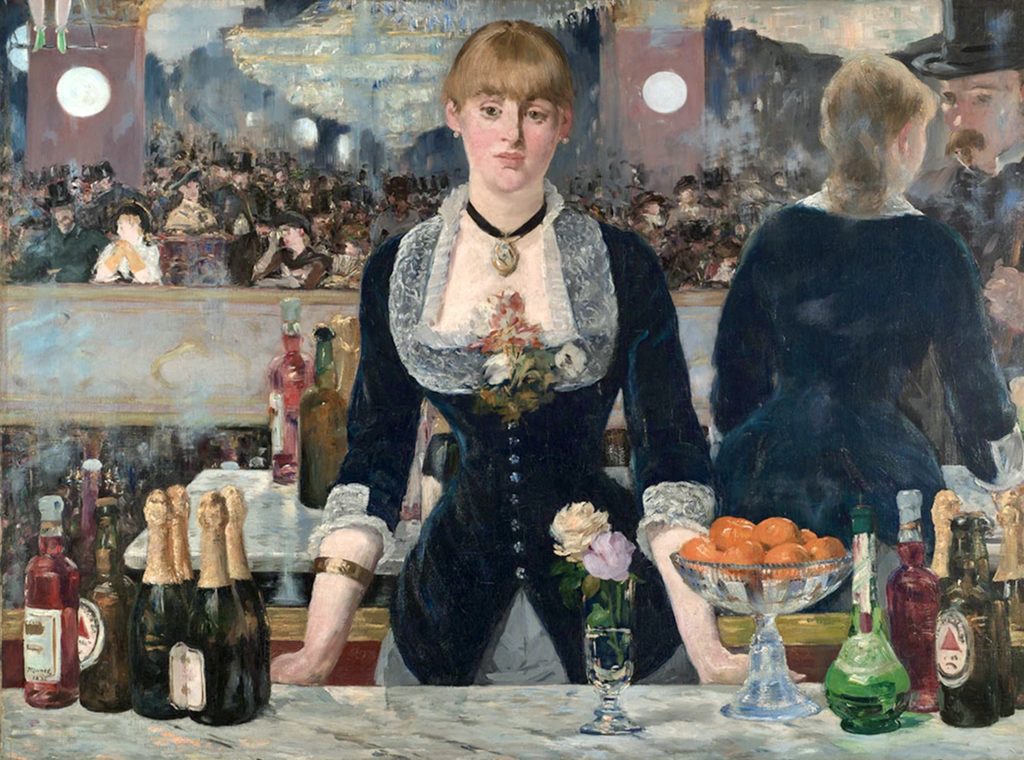
Courtauld Gallery
13. Edouard Manet, Bar at the Folies-Bergere
Manet is known as the “Father of Impressionism” and had a huge impact on the development of modernism. He scandalized the official Salon with his utter disregard for academic conventions and strikingly modern images of urban life.
Folies-Bergere was Manet’s last major painting. It immortalizes a famous music hall in the Montmartre neighborhood of Paris.
Manet uses shimmering color, controlled brushwork, and rigorous design to evoke the gaslit atmosphere of a cafe.
The large distorted mirror behind the barmaid contains much of the visual information of the painting in unfocused images. It creates a disorientating effect.
The barmaid dominates the composition. She has an enigmatic, almost obdurant, expression. While she is firmly painted, her reflection in the mirror is blurry.
The man she is serving is almost an afterthought in the upper right corner. There’s a distractingly beautiful still life on the counter.
READ: Guide To The Courtauld Gallery
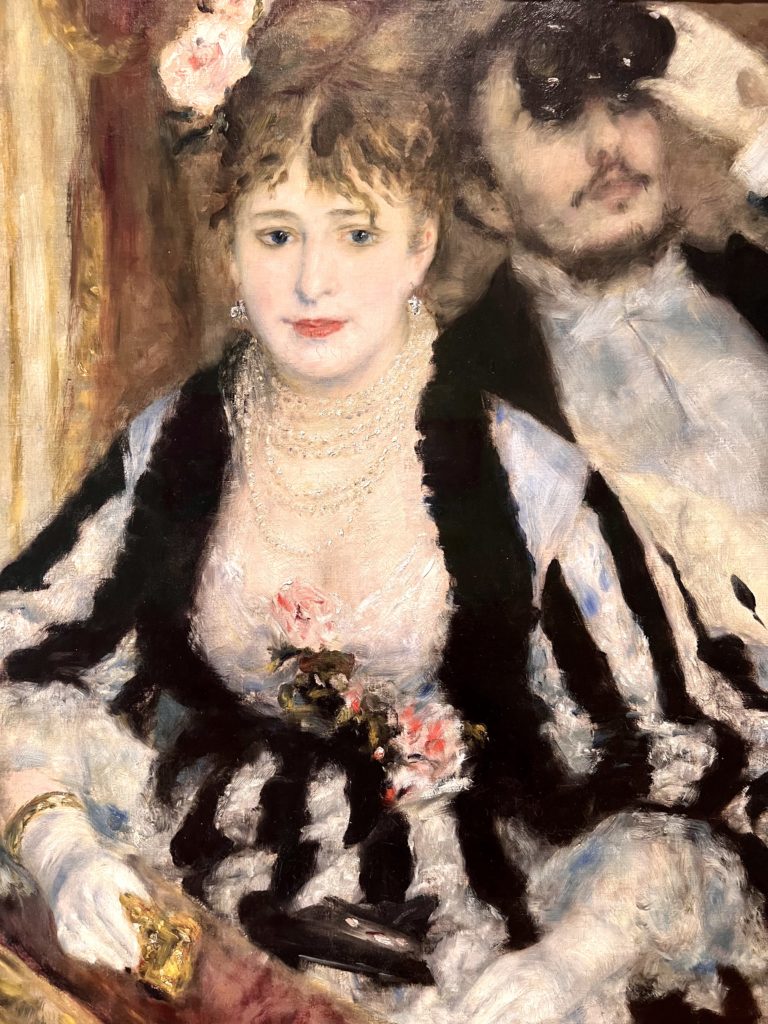
14. Pierre-Auguste Renoir, La Loge
This early Renoir piece may be inspired by the English tradition of monumental portraiture.
It shows a couple in the interior of a theater box. It was exhibited at the first Impressionist group exhibition in Paris in 1874.
The staging of the figures is unconventional. The woman dominates the tightly cropped scene, appearing as an accessible flesh and blood woman.
The extremely dramatic dress creates a symphony of black and white colors.
Renoir’s brushstrokes are delicate. This soft hued painting would help establish Renoir as one of the leading Impressionist painters of his generation.
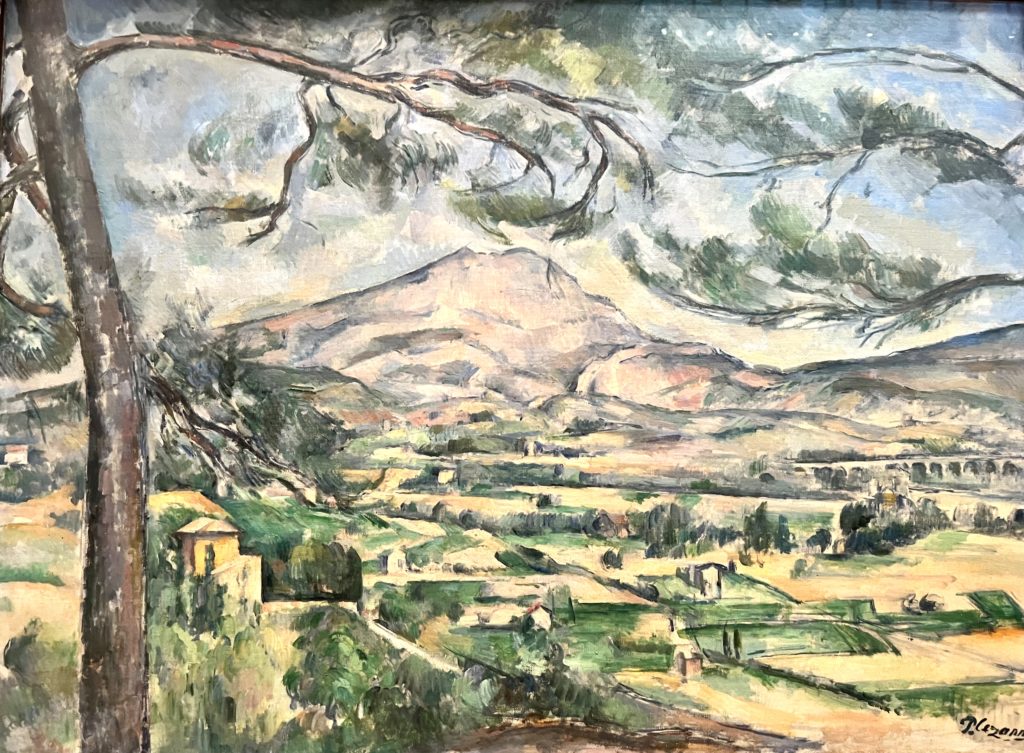
15. Cezanne, Sainte-Victoire
Cezanne was a hugly influential painter of the late 19th century. Monet called Cezanne “the greatest of us all.” For Picasso, he was the father of modern art.
Cezanne threw away the long prevailing convention of single point perspective. He used multiple perspectives in a single canvas, portraying objects as sets of abstract shapes.
Mont Sainte-Victoire was an obsessive motif of Cezanne’s. The mountain dominated the landscape of Cezanne’s home in Aix-en-Provence in southern France.
The artist painted many iterations of the mountain from different vantage points throughout his career. He painted the plains and lines of cypress in varying shades of green.
He wasn’t aiming for beauty, but authenticity. Cezanne’s paintings suggested and imagined abstraction before other artists made it a reality.
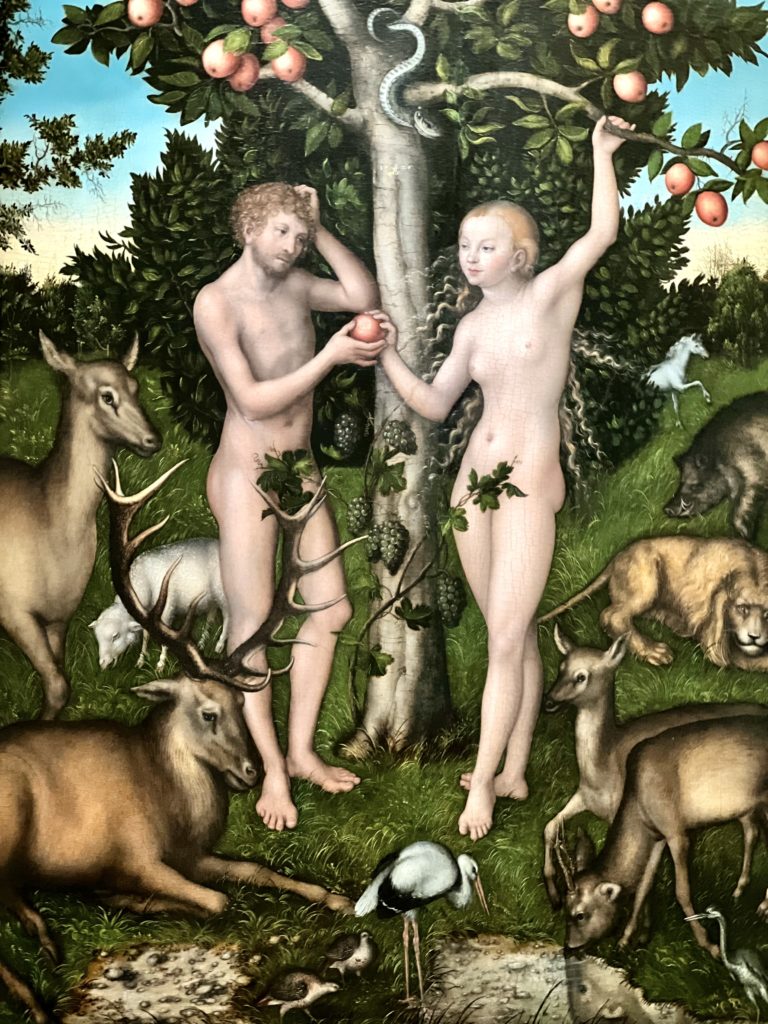
16. Lucas Cranach, Adam and Eve
In this famous painting, Cranach depicts Adam and Eve at the fateful moment when they disobey god. Hoping to to distinguish between good and evil like god, Eve bites into an apple from the Tree of Knowledge. Adam hesitates and then also eats.
Every last inch of the canvas shows Cranach’s precision and consideration. There is perfect harmony of the colors. Cranach’s slender undulating figures conform to the courtly ideals of beauty.
Cranach depicts the scene as serene and peaceful. Animals are at their feet.
Cranach and his workshop created over 50 versions of Adam and Eve. This is one of his largest and most beautiful.
Adam and Eve are rendered somewhat seductively, to heighten the theme of temptation. The snake watches them from the tree above.
17. Vincent Van Gogh, Self Portrait with Bandaged Ear
Vincent Van Gogh is a beloved Post-Impressionist painter. His work is notable for its swirling line, emotional honesty, and bold vivid color.
Van Gogh is famous for his self portraits. He painted 43 of them.
This one was painted a week after cutting off his ear. Van Gogh had quarreled with fellow painter and friend Paul Gauguin. Gauguin walked out, dashing Van Gogh’s dream of launching an artist “studio of the south.”
The portrait is a little misleading. Van Gogh actually cut off the lower lob of his left ear. But because he painted his self portrait in front of a mirror, the right ear appears bandaged.
The self portrait reflects both the zenith of the artist’s bold painting power and his personal struggles.
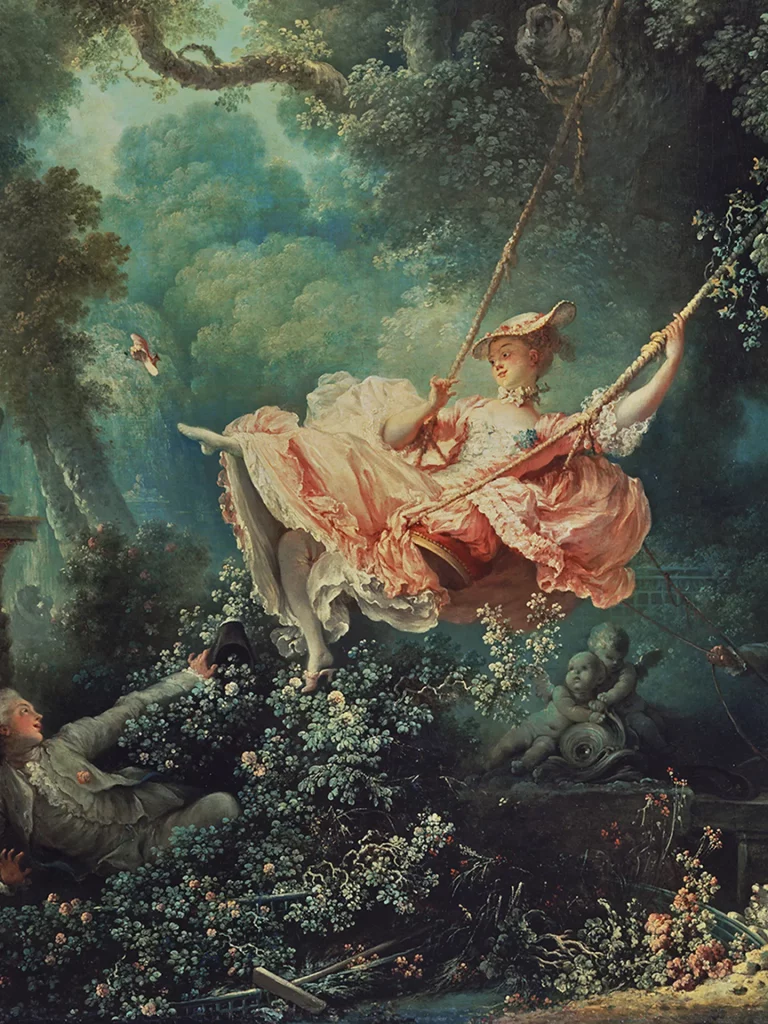
The Wallace Collection
18. Fragonard, The Swing
The Swing is an iconic painting of the Rococo and the most famous painting by Jean Honore Fragonard. It was most likely commissioned by famed 18th century libertine Baron de St. Julien.
Fragonard was the first of the great Romantic painters. His reputation rests mainly on his playful love scenes. Fragonard was renowned for his use of light and color and expressive brushstrokes.
The Swing is classic Fragonard — a naughty subject executed with grace. It features a tantalizing woman.
She’s decked out in a frothy pink gown, flying through the air. The joyful painting is set in a blue and mint green landscape that defies nature.
The woman on the swing is being pulled by her husband, who is hidden in the dark shadows on the right. The poor man is unaware that she is having an affair with another man on the left.
The woman throws up her left leg and shows herself to her lover. She flirtatiously kicks off a slipper, a symbol of sexual abandon.
READ: Guide To The Wallace Collection
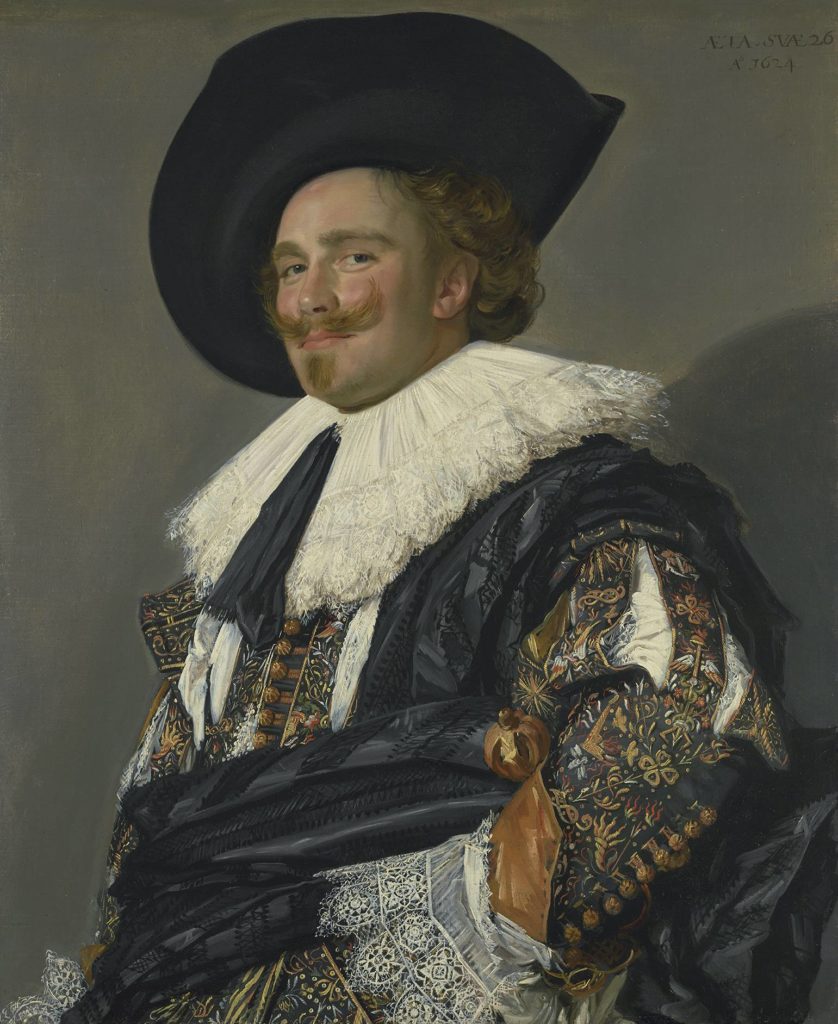
19. Fran Hals, The Laughing Cavalier
The Laughing Cavalier was painted by Franz Hals, a preeminent Dutch Golden Age painter.
It’s an exuberant half length portrait of a young man, executed in a loose painting style. His smirk suggests he is having a good time.
Art historians don’t know who the painting depicts. The subject’s flamboyant clothing suggests he’s a rich merchant or prominent citizen.
His clothing is embroidered with symbols of courtship. This suggests the painting may have been a betrothal portrait.
The title claims the man is laughing. And the arrogant pose in the portrait certainly conveys a sense of jocularity and swagger.
But that is likely just an image created by the shape of his distinctive mustache. In reality, he is neither laughing nor a cavalier.
In the painting, you can see Hals’ trademark use of various shades of black. His sumptuous and fluid textures give the painting a photographic quality.
Tate Modern
20. Mark Rothko, Seagram Murals
Mark Rothko is an American abstract expressionist painter. Rothko was originally commissioned by Seagram to create these murals for its Four Seasons restaurant in New York City’s Seagram Building.
In 1959, Rothko abruptly quit the prestigious gig. Apparently, he didn’t want his art to be mere decoration for wealthy patrons.
Instead, the Seagram Murals took on a darker and more contemplative turn. Michelangelo’s Laurentian Library in Florence Italy influenced Rothko’s meditations.
He used a somber color coordinated palette of deep red, browns, and blacks to create soft edged and uncentered rectangles. Rothko sought to re-create the library’s claustrophobic and sepulchral atmosphere.
The murals are displayed in dark, dimly lit rooms. At the time, some criticized them as “Apolcalypse Wallpaper.”
Some of the Seagram Murals are on display at the Tate Modern and others are at the Tate Britain.
>>> Click here to book a tour of the Tate Modern
21. Andy Warhol, Marilyn Diptych
Andy Warhol was a true iconoclast and performance artist. As the Prince of Pop, he was a hugely significant artist of the second half of the 20th century.
Marilyn Monroe was the perfect subject for Warhol, a man obsessed with both celebrity and death. Monroe was a talented but misunderstood starlet, whose star burned brightly but was the victim of her own success.
Immediately after her death in 1962, Warhol created theatrical day glow silkscreens of her face for months on end. The silkscreens make clear that Monroe herself had become an actual object.
On the left of this diptich, there’s image of a “shot sage blue Marilyn.”: She has yellow hair, bright blue eye shadow, and luminous bright red lips.
The silkscreens fades from acid bright images to black and white, hinting at her mortality.
22. Pablo Picasso, Nude Woman With Necklace
Picasso was the most dominant and influential artist of the first half of the 20th century, dabbling in Cubism and Surrealism. He created portraits of nude women throughout his life.
Picasso painted this colorful portrait when he was 87. It depicts his second and last wife, Jacqueline Roque.
Her mask-like facial expression is enigmatic and filled with mystery. Is she vulnerable or defiant?
Her figure is chaotic with body parts bulging out. It’s a sexualized arrangement of various body parts that seems intended to shock and unsettle.
READ: Guide To the Picasso Museum in Paris
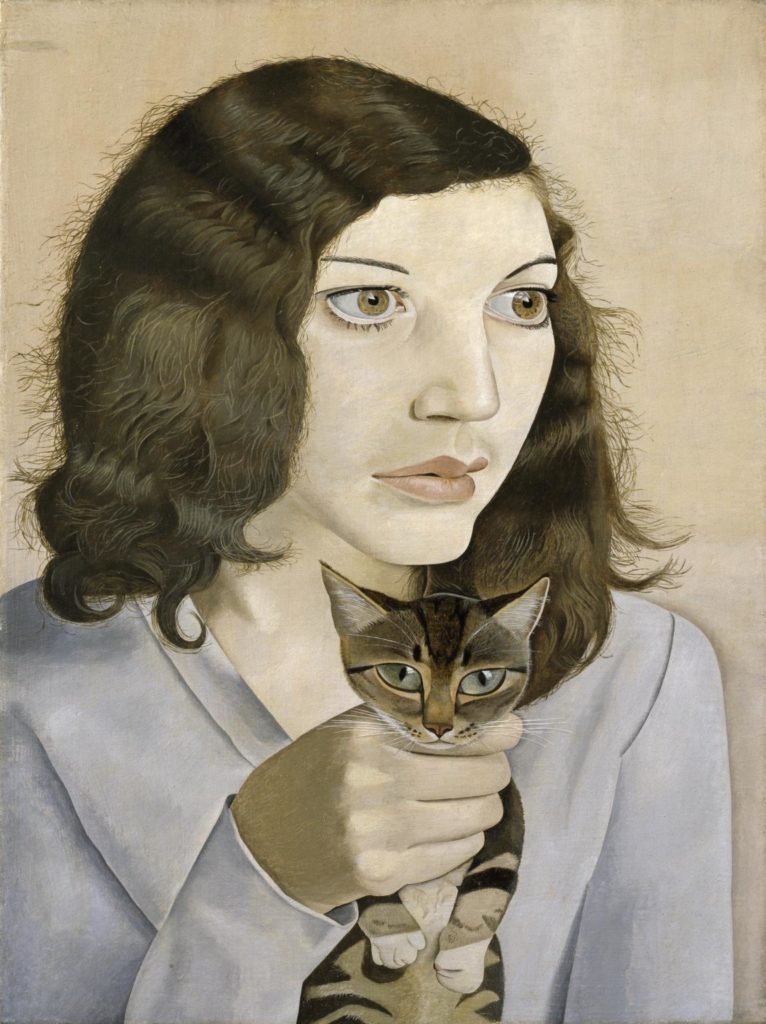
23. Lucian Freud, Girl with a Kitten
Lucian Freud is considered one of the most important figurative painters of the 20th century. He essentially redefined the art of portraiture.
The grandson of the psychoanalyst Sigmund Freud, Freud’s work involved the odd process of observation. He became famous for his unflinching portrayals of human anatomy.
Freud used an anti-romantic, confrontational style of portraiture that stripped bare the sitter’s social facade. This portrait is one of eight he made of his first wife Kathleen Garmen.
She holds the kitten in a tight grip, almost half strangling the animal. Since Garmen was know as “Kitty,” it suggests something is wrong with her own psyche or her marriage.
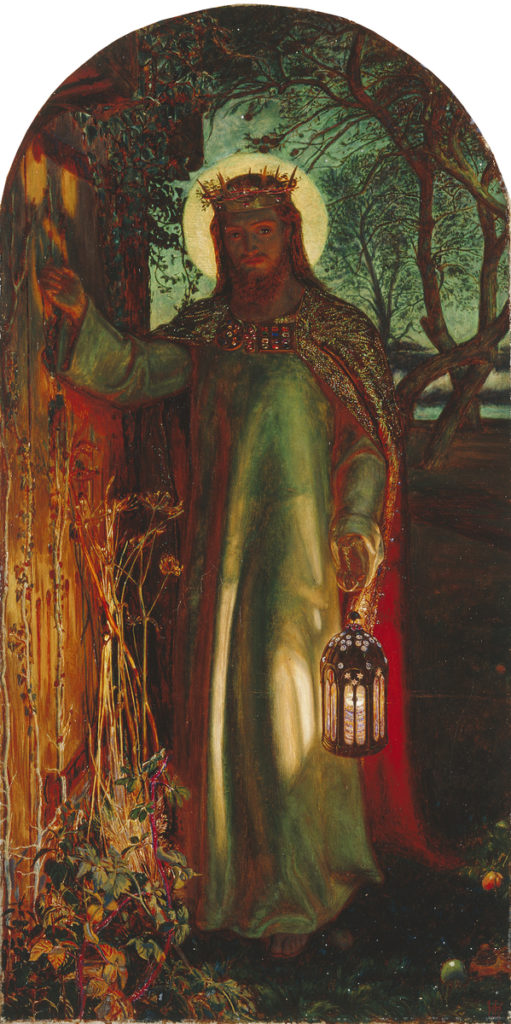
St. Paul’s Cathedral
24. William Holman Hunt, Light of the World
One of London’s most famous paintings in inside St. Paul’s Cathedral in the Chapel of Saints Erkenwald and Ethelburga.
It’s a beautiful altarpiece painted by the Pre-Raphaelite artist William Holman Hunt called the Light of the World. It’s intended to illustrate Revelation 3:20.
The painting depicts Christ in a dark wood. He holds a lantern and knocks at an overgrown door with no handle. The door symbolizes the human soul, who can choose to follow or not follow Christ.
In 1905, the painting traveled the world and achieved cult status. The work is so important that it was evacuated during WWII.
>>> Click here to book a ticket to St. Paul’s Cathedral
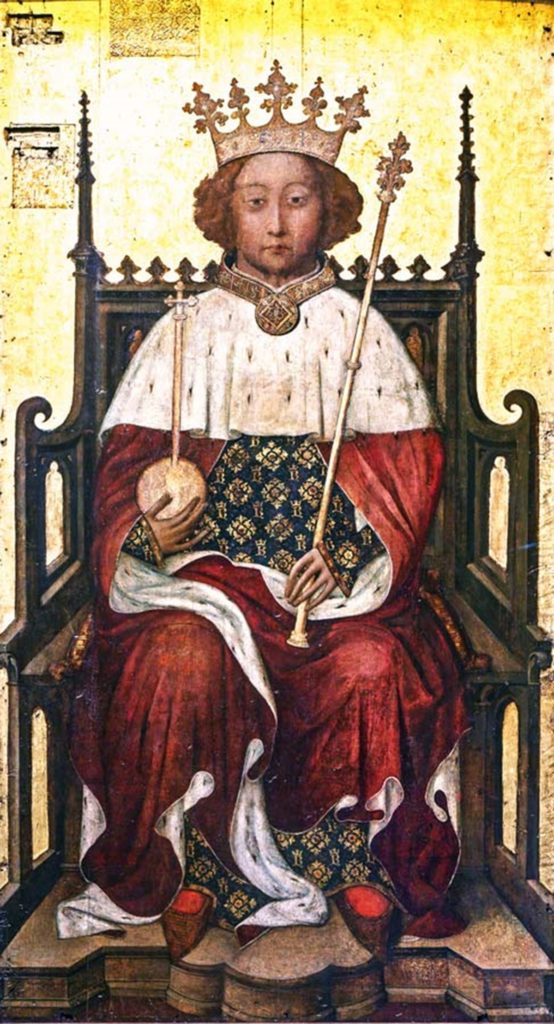
Westminster Abbey
25. Painting of Richard II
A 14th century painting of Richard II hangs in the west end of the Westminster Abbey. You might miss if you don’t seek it out.
It’s an incredibly important work of art. It was the first portrait of an English sovereign to be painted in his lifetime.
It’s one of the best medieval paintings in existence in any country. The painting is 7 x 3.5 feet, but seems larger.
>>> Click here to book a ticket to Westminster Abbey
Sir John Soane Museum
26. William Hogarth, The Rake’s Progress, 1732-34
The Sir John Soane Museum is home to paintings by 18th century artist and satirist William Hogarth. Hogarth liked to poke fun at the foibles and morality of society in paintings that he called “modern moral subjects.”
The Rake’s Progress is series of 8 paintings. They depict the tale of a young man who inherits a fortune and blithely squanders it. He ends up in debtor’s prison and, eventually, an insane asylum.
But the work is not entirely judgmental. Hogarth reminds his audience that none of us is more than a few steps from perdition.
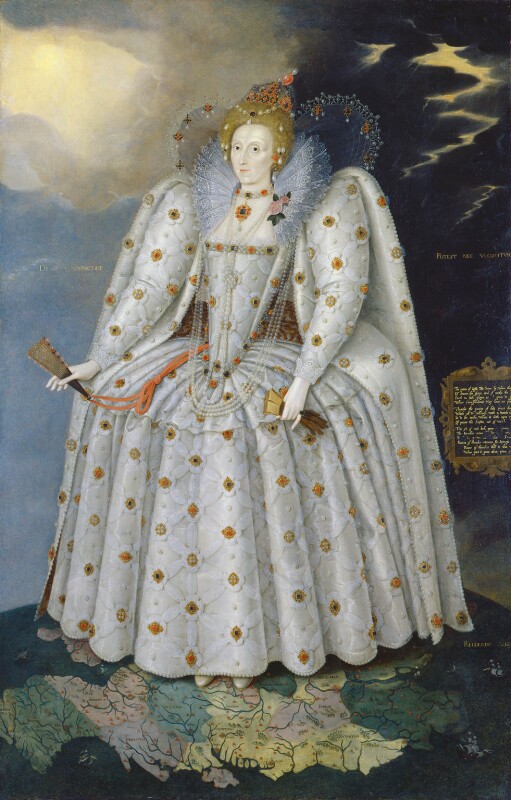
National Portrait Gallery
27. The Ditchley Portrait of Queen Elizabeth I
Known as the Ditchley Portrait, this famous painting in London was created by Marcus Gheeraerts the Younger for Sir Henry Lee.
Lee was the Queen’s Champion for 30 years from 1559-90. At the time, Gheeraerts was the most fashionable portraitist of the day and so was hired.
The portrait most likely commemorates an elaborate entertainment which Lee organized for the Queen in 592. It was held at his house in Ditchley.
The portrait shows Elizabeth in elaborate attire. She stands on the globe of the world, with her feet on Oxfordshire.
The clouds part to reveal sunshine. The theme may be one of forgiveness, with Elizabeth forgiving Lee for an affair.
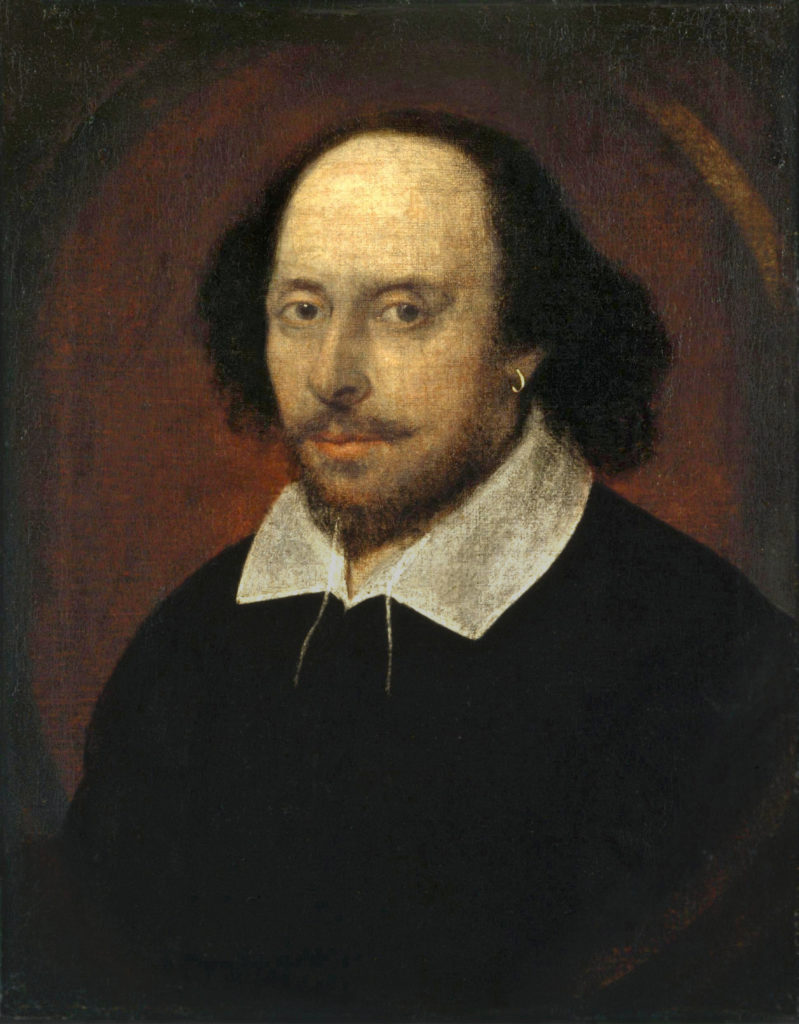
28. John Tyler, William Shakespeare
This is thought to be one of the only contemporaneous portraits of the famous playwright William Shakespeare.
It was likely created by the painter John Taylor. He was an important member of the Painter-Stainers’ Company.
The portrait is known as the Chandos Portrait, after a previous owner. It was the first portrait to be acquired by the National Portrait Gallery, when it was founded in 1856.
READ: Guide To Shakespeare’s Globe Theater
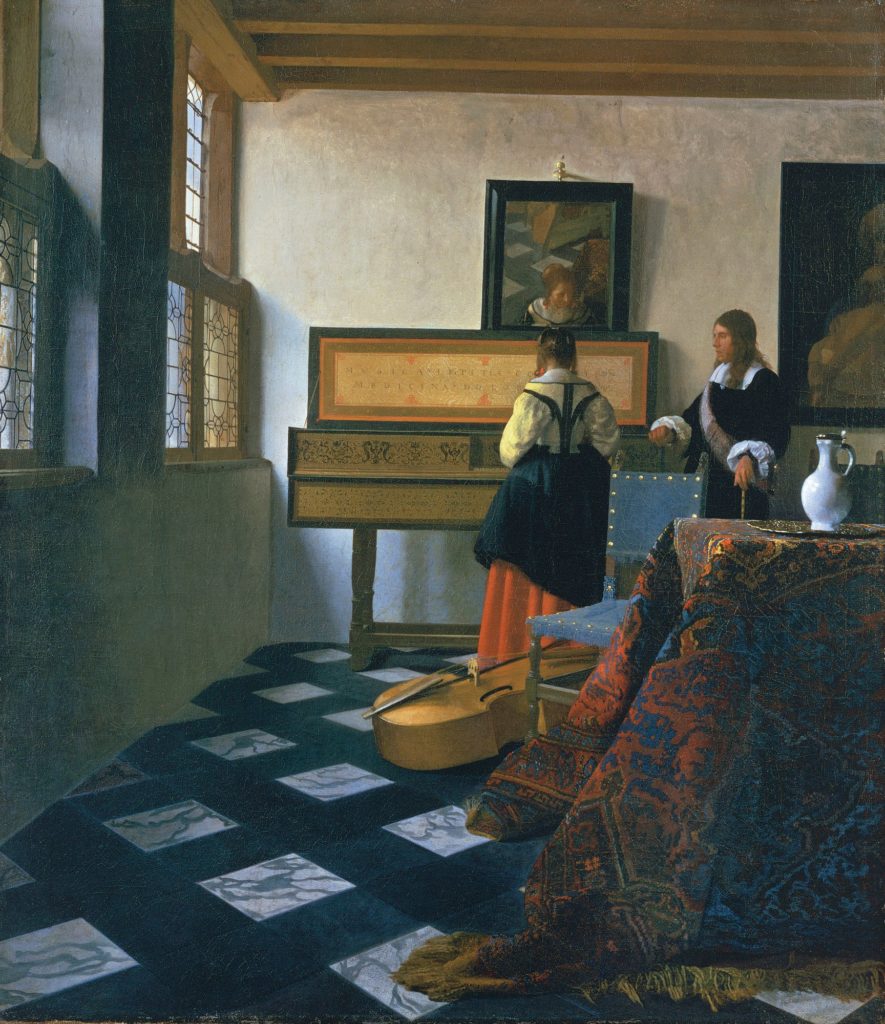
Queen’s Gallery, Buckingham Palace
29. Vermeer, A Lady at the Virginal with a Gentleman, 1662-65
Vermeer was one of the premiere painters of the Dutch Golden Age. He specialized in domestic interior scenes of middle class life. There are very few Vermeer paintings in the world.
In this one, two figures make music in a sunlit room. The painting demonstrates Vermeer’s trademark sense of rhythm and stability.
As with all his paintings, light permeates the scene, beautifully rendering his subjects using light and shadow.
The composition uses a rigorous perspective to draw the eye towards the back of the room where the figures are situated.
A striking feature of the composition is the mirror on the wall. In it, you see slightly blurred reflections that include the young woman’s face, part of the table and the legs of an artist’s easel.
>>> Click here to book a ticket to the Queen’s Gallery
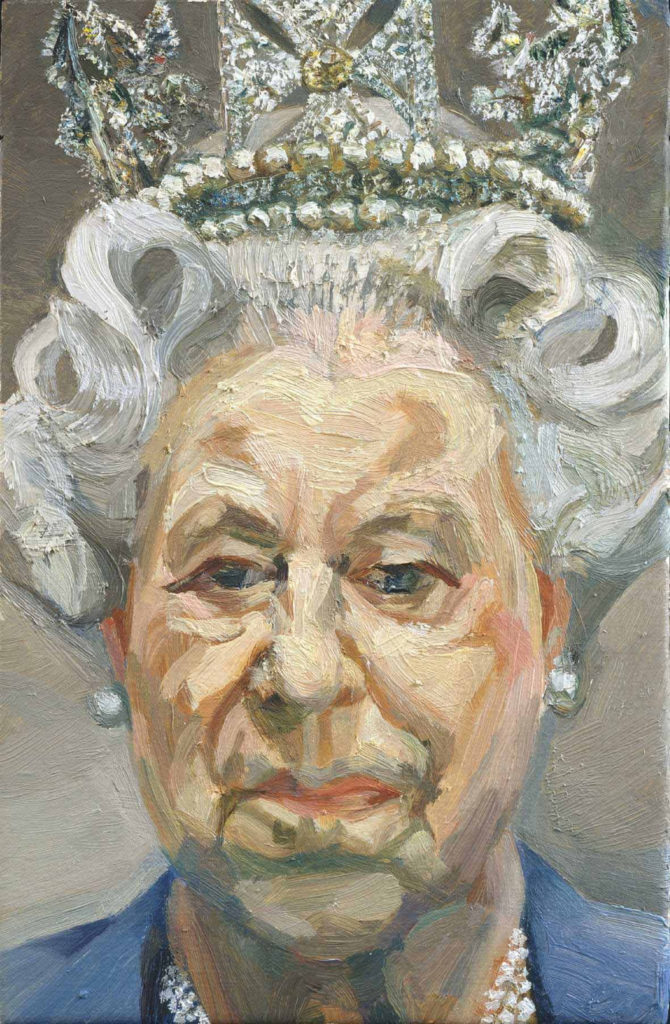
30. Lucian Freud, Queen Elizabeth II
As I mentioned above, Freud used a style of portraiture that stripped bare the sitter’s social facade. His images were intensely realized and almost intentionally uglified.
Freud painted many portraits of famous people throughout his career. The Queen is perhaps his most powerful and globally recognizable subject. The entire portrait is filled with her rather imposing face.
The portrait was controversial. Freud was accused of painting the Queen in an unflattering light.
But really the painting just has his trademark intensity, a trademark he refused to compromise. Some critics argued that it didn’t even look like the queen, suggesting it was stand-in for the artist himself.
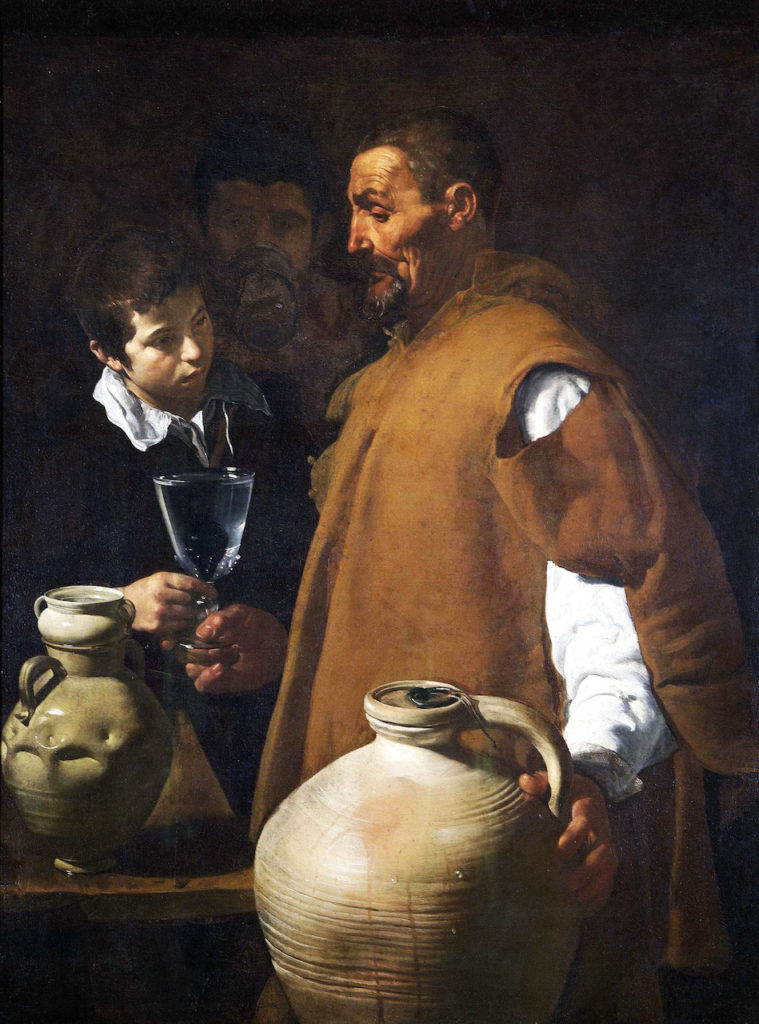
Apsley House
31. Diego Velazquez, The Waterseller of Seville
Velazquez did three versions of The Waterseller of Seville. The best version is in London’s underrated Apsley House.
The subject of this Baroque masterpiece is a waterseller known as “the Corsican of Seville.” In this calm and quiet picture, Velazquez ennobles the peasant by giving him the appearance of a saint or monk.
The man seems almost unaware of his surroundings. He has a faraway look in his eyes that suggests a profound acceptance of life.
Visiting Museums In London
London’s national museums are free to visit. In high season, you may need to book a timed entry slot online for popular ones like the National Gallery of Art or the British Museum.
For other places, like St. Paul’s Cathedral or Westminster Abbey, you should book skip the line tickets in advance. Many of these attractions and the smaller museums are also included in the London Pass.
I hope you’ve enjoyed my guide to famous paintings in London. You may enjoy these other London travel guides and resources:
- 3 Day Itinerary for London
- 5 Day Itinerary for London
- Best Museums in London
- Harry Potter Places in London
- Guide to St. Paul’s Cathedral
- Guide to the Tate Britain
- Guide to Wesminster Abbey
- London Tourist Traps To Avoid
- Guide to the Tower of London
- Guide to the Churchill War Rooms
If you need a London art bucket list, pin it for later.

